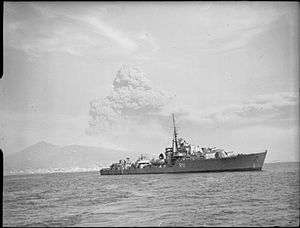HMS Tumult (R11)
 HMS Tumult during the eruption of Mount Vesuvius, 1944 | |
| History | |
|---|---|
| Name: | HMS Tumult |
| Ordered: | 14 March 1941 |
| Builder: | John Brown & Company |
| Laid down: | 16 November 1941 |
| Launched: | 9 November 1942 |
| Commissioned: | 2 April 1943 |
| Reclassified: | Converted to Type 16 frigate 1949-50 |
| Identification: | pennant number R11/F121 |
| Honours and awards: |
|
| Fate: | Scrapped 25 October 1965 |
| General characteristics | |
| Class and type: | T-class destroyer |
| Displacement: | |
| Length: | 362 ft 9 in (110.6 m) (o/a) |
| Beam: | 35 ft 9 in (10.9 m) |
| Draught: | 14 ft 6 in (4.4 m) (deep) |
| Installed power: |
|
| Propulsion: | 2 × shafts; 2 × Parsons geared steam turbines |
| Speed: | 36 knots (67 km/h; 41 mph) |
| Range: | 4,675 nmi (8,658 km; 5,380 mi) at 20 knots (37 km/h; 23 mph) |
| Sensors and processing systems: |
|
| Armament: |
|
HMS Tumult was a T-class destroyer built for the Royal Navy during the Second World War.
Description
Tumult displaced 1,710 long tons (1,740 t) at standard load and 2,530 long tons (2,570 t) at deep load. She had an overall length of 362 feet 9 inches (110.6 m), a beam of 35 feet 8 inches (10.9 m) and a deep draught of 14 feet 6 inches (4.4 m). She was powered by two Parsons geared steam turbines, each driving one propeller shaft, using steam provided by two Admiralty three-drum boilers. The turbines developed a total of 40,000 shaft horsepower (30,000 kW) and gave a maximum speed of 36 knots (67 km/h; 41 mph). Tumult carried a maximum of 615 long tons (625 t) of fuel oil that gave her a range of 4,675 nautical miles (8,658 km; 5,380 mi) at 20 knots (37 km/h; 23 mph). Her complement was 170 officers and ratings.[1]
The ship was armed with four 45-calibre 4.7-inch (120 mm) Mark XII guns in dual-purpose mounts. For anti-aircraft (AA) defence, Tumult had one twin mount for Bofors 40 mm guns and four twin 20-millimetre (0.8 in) Oerlikon autocannon. She was fitted with two above-water quadruple mounts for 21-inch (533 mm) torpedoes. Two depth charge rails and four throwers were fitted for which 70 depth charges were provided.[2]
Construction and career
In 1946, Tumult was placed into reserve at Portsmouth. She remained in reserve until 1953 when was converted by Grayson Rollo at Birkenhead, into a Type 16 fast anti-submarine frigate, with the new pennant number F121.[3] She emerged from the conversion in 1954. In November 1956 she was part of the 2nd Training Squadron at Portsmouth. Between December 1957 and December 1960 she was part of the Chatham reserve. From December 1960 until October 1965 she was part of the Rosyth reserve.
Following sale for scrap she was taken to Arnott Young at Dalmuir for breaking up, where she arrived on 25 October 1965.
References
Bibliography
- Chesneau, Roger, ed. (1980). Conway's All the World's Fighting Ships 1922–1946. Greenwich, UK: Conway Maritime Press. ISBN 0-85177-146-7.
- Colledge, J. J.; Warlow, Ben (2006) [1969]. Ships of the Royal Navy: The Complete Record of all Fighting Ships of the Royal Navy (Rev. ed.). London: Chatham Publishing. ISBN 978-1-86176-281-8. OCLC 67375475.
- English, John (2001). Obdurate to Daring: British Fleet Destroyers 1941–45. Windsor, UK: World Ship Society. ISBN 978-0-9560769-0-8.
- Lenton, H. T. (1998). British & Empire Warships of the Second World War. Annapolis, Maryland: Naval Institute Press. ISBN 1-55750-048-7.
- Raven, Alan; Roberts, John (1978). War Built Destroyers O to Z Classes. London: Bivouac Books. ISBN 0-85680-010-4.
- Whitley, M. J. (1988). Destroyers of World War 2. Annapolis, Maryland: Naval Institute Press. ISBN 0-87021-326-1.